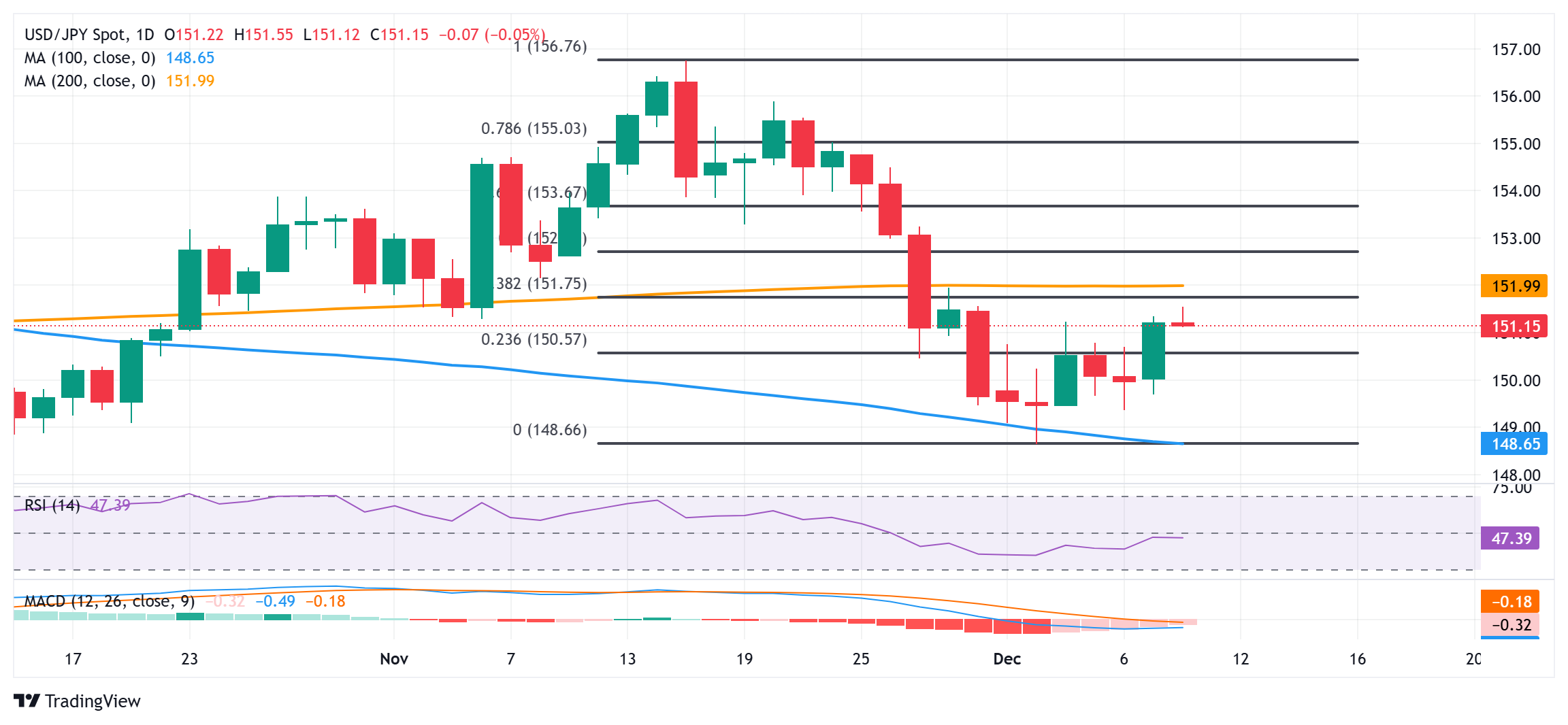- The Japanese Yen falls to a more than one-week low against its US counterpart on Tuesday.
- Doubts about the BoJ’s ability to raise interest rates turn out to be a key factor weakening the JPY.
- Expectations of a less dovish Fed act as a tailwind for the USD and contribute to the modest rally.
The Japanese Yen (JPY) loses ground against its US counterpart for the second day in a row on Tuesday and lifts the USD/JPY pair to a more than one-week high, above the 151.00 area during the Asian session on Tuesday. Uncertainty over how soon the Bank of Japan (BoJ) could raise interest rates again keeps JPY bulls on the defensive. Additionally, the overnight bounce in US Treasury yields from October lows weakens the low-yielding JPY. Apart from this, the post-NFP recovery of the US Dollar (USD) from a nearly one-month low, driven by expectations of a less dovish Federal Reserve (Fed), acts as a tailwind for the currency pair.
That said, a softer risk tone, concerns that US President-elect Donald Trump’s tariff plans could trigger a second wave of global trade wars and geopolitical tensions help limit deeper losses for the safe haven JPY. Traders could also refrain from placing aggressive bullish bets on the USD/JPY pair and opt to wait for the release of the latest US consumer inflation figures, due out on Wednesday. The crucial US Consumer Price Index (CPI) report will be watched for fresh clues on the Fed’s rate cut path. This, in turn, will boost demand for the USD and provide a significant boost to the currency pair ahead of the risks of key central bank events next week.
Japanese Yen Continues to Lose Ground Amid Mixed Signals on BoJ Rate Hike
- Bank of Japan Governor Kazuo Ueda recently said the time for the next rate hike was approaching. This, along with data showing that core inflation in Japan remains strong, raised expectations that the BoJ will raise rates at its December 18-19 monetary policy meeting.
- Some media reports, however, suggested that the BoJ could skip a rate hike this month. Additionally, moderate BoJ board member Toyoaki Nakamura said the central bank should act cautiously in raising rates, adding a layer of uncertainty and weakening the Japanese yen.
- The US Nonfarm Payrolls (NFP) report released on Friday reaffirmed expectations of a rate cut by the Federal Reserve in December. The Fed, however, could issue a message of caution amid expectations that US President-elect Donald Trump’s policies could reignite inflationary pressures.
- The 10-year US government bond yield posted a modest rebound on Monday, after closing at its lowest level since October 18 last Friday. This helps the US Dollar (USD) build on the post-NFP recovery and provides a modest boost to the USD/JPY pair.
- Investors remain concerned about Trump’s impending trade tariffs and their effect on the global economic outlook. Additionally, turbulence in the Middle East increased over the weekend after Syrian rebels took control, forcing President Bashar al-Assad to flee to Russia.
- The main event this week will be the release of the US Consumer Price Index for November on Wednesday, which should offer clues about the outlook for interest rates in the US. This, in turn, should influence in the currency pair ahead of the FOMC/BoJ monetary policy meetings next week.
USD/JPY could face strong resistance near the 151.75-152.00 confluence
From a technical perspective, any further move higher will likely face stiff resistance and remain capped near the 151.75-152.00 confluence. Said area comprises the 38.2% Fibonacci retracement level of the recent pullback from a multi-month high touched in November and the very important 200-day Simple Moving Average (SMA). Since the oscillators on the daily chart have recovered from negative territory, a sustained move beyond the 152.00 mark should pave the way for additional gains towards the 152.70-152.75 region, or the 50% retracement level. This is followed by the round figure of 153.00, above which the USD/JPY pair could extend the momentum towards the 61.8% Fibonacci level, around the 153.70 zone.
On the other hand, weakness below the 151.00 mark now appears to find decent support near the 150.60 region, or the breakout point of the 23.6% Fibonacci resistance level. The next relevant support lies near the 150.00 psychological mark, below which the USD/JPY pair could weaken towards the 149.50-149.45 region en route towards the 149.00 mark and the monthly low, around the 148.65 touched last week. The latter coincides with the 100-day SMA and a convincing break below will be seen as a new trigger for the bears, and will set the stage for a new short-term depreciation move.
The Japanese Yen FAQs
The Japanese Yen (JPY) is one of the most traded currencies in the world. Its value is determined broadly by the performance of the Japanese economy, but more specifically by the policy of the Bank of Japan, the differential between the yields of Japanese and US bonds or the risk sentiment among traders, among other factors.
One of the mandates of the Bank of Japan is currency control, so its movements are key for the Yen. The BoJ has intervened directly in currency markets on occasion, usually to lower the value of the Yen, although it often refrains from doing so due to the political concerns of its major trading partners. The BoJ’s current ultra-loose monetary policy, based on massive stimulus to the economy, has caused the depreciation of the Yen against its main currency pairs. This process has been exacerbated more recently by a growing policy divergence between the Bank of Japan and other major central banks, which have opted to sharply raise interest rates to combat decades-old levels of inflation.
The Bank of Japan’s ultra-loose monetary policy stance has led to increased policy divergence with other central banks, particularly the US Federal Reserve. This favors the widening of the spread between US and Japanese 10-year bonds, which favors the Dollar against the Yen.
The Japanese Yen is often considered a safe haven investment. This means that in times of market stress, investors are more likely to put their money in the Japanese currency due to its supposed reliability and stability. In turbulent times, the Yen is likely to appreciate against other currencies that are considered riskier to invest in.
Source: Fx Street
I am Joshua Winder, a senior-level journalist and editor at World Stock Market. I specialize in covering news related to the stock market and economic trends. With more than 8 years of experience in this field, I have become an expert in financial reporting.








